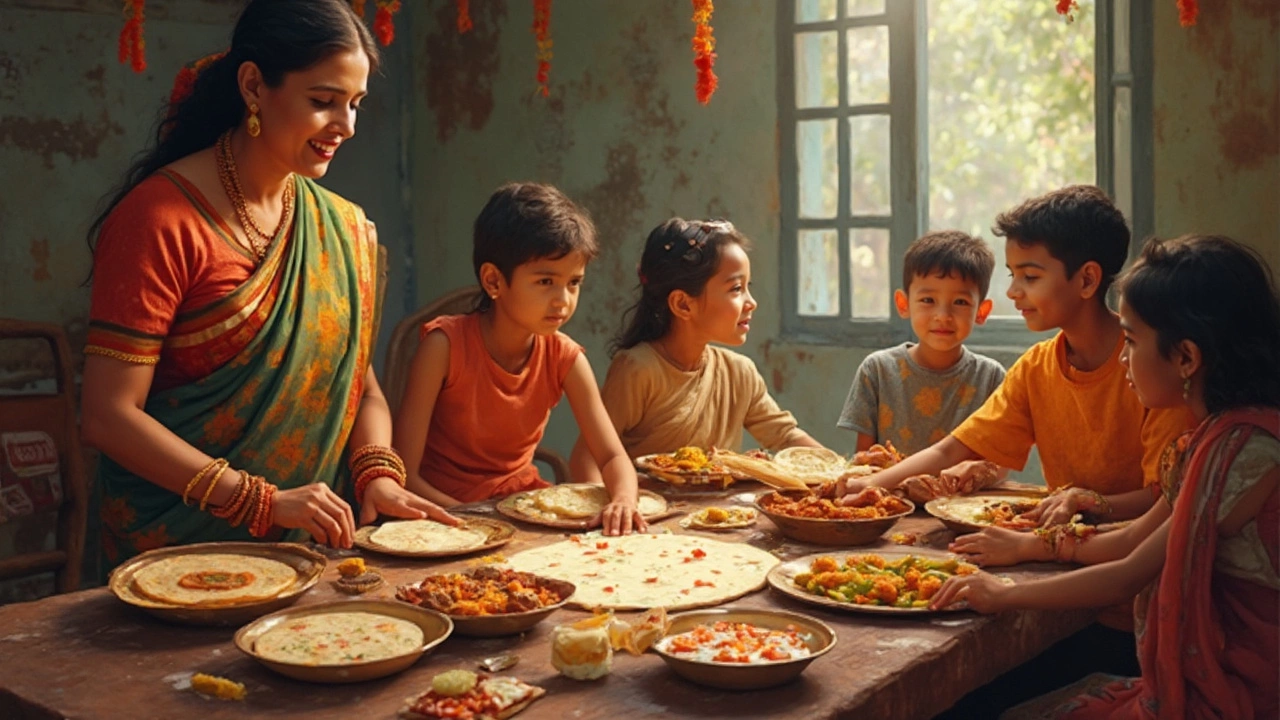How Many Chapatis Should You Eat in a Day? A Nutritionist’s Guide
 Mar, 5 2025
Mar, 5 2025
Chapatis, a staple in many Indian households, raise a curious question: how many should you eat in a day? While the answer isn’t the same for everyone, it revolves around knowing your own body's needs. It starts with understanding how many calories are packed in a single roti. Generally, there are around 70-80 calories in one roti, although this can vary based on size and ingredients.
So, how do you figure out how many chapatis fit into your daily diet? You need to consider your Body Mass Index, or BMI. This handy metric gives you a snapshot of your body weight compared to your height, helping gauge if you’re in a healthy range. The higher your BMI, the more careful you should be about calorie intake.
To tailor your diet, a calorie calculator comes to the rescue. It helps you sum up the calories from all your meals, giving insight into how many chapatis you can accommodate. But don’t worry, you don’t need to do this every day—a rough estimate once a week should help keep things balanced.
- Understanding Chapatis and Calories
- Factors Influencing Daily Intake
- Body Mass Index and Diet
- Using a Calorie Calculator
- Legal and Cultural Aspects
- Tips for a Balanced Diet
Understanding Chapatis and Calories
If you’ve ever wondered about the nutritional impact of your favorite roti, you're not alone. Let's break it down so you can make informed choices about your meals. A standard chapati consists of whole wheat flour, water, and sometimes a bit of oil or ghee. On average, one chapati carries about 70-80 calories, and it’s mostly carbs with a bit of protein and fat.
Now, how does this fit into your daily diet? Here's a quick step-by-step guide:
- Start by identifying how many calories you need daily. This is usually based on factors like age, gender, physical activity, and goals (like losing weight or maintaining it).
- Use a calorie calculator to get a precise number that suits your lifestyle. Remember, the idea is not just to track chapatis but your entire meals for the day.
- Know that Calories in One Roti can add up quickly if you're not mindful. If you're consuming multiple chapatis, consider cutting back on other carbs in your meals to keep balance.
Here’s a fun fact for our fitness enthusiasts: chapatis are often preferred over rice because they tend to keep you fuller for longer due to their fiber content. Plus, in many parts of India, chapatis are a staple meal, and knowing their nutritional value empowers you to make right choices without giving up on cultural preferences.
Legal Aspects and Labeling
When buying packaged chapatis or flour, check the labeling. In countries like India, it’s mandatory for nutritional labeling on packaged foods, including calorie content and ingredients. This ensures that you’re aware of what goes into making those chapatis.
Taking a local perspective, regional diets might alter recipes a bit. Places with higher chapati consumption often adapt healthier versions, like those using millets or additional grains, to pack in more nutrition. Be sure to check out what's available locally and try them out!
Factors Influencing Daily Intake
Deciding how many chapatis you should eat a day isn’t random—it's influenced by several factors. Understanding these can help tailor your diet to fit your lifestyle and health goals. Let's break it down.
1. Your Activity Level
A major factor is how active you are. If you're someone who hits the gym regularly or has a physically demanding job, you'll burn more calories, meaning you can afford to eat a few more chapatis. On the flip side, if you have a sedentary lifestyle, think fewer chapatis, more salads.
2. Caloric Needs
Your daily caloric needs differ based on age, gender, and fitness goals. A free online calorie calculator can help you determine how many total calories you need, making it easier to see how many chapatis can fit into your daily diet. For instance, women generally require around 1,800-2,200 calories, while men need around 2,200-2,700 calories daily.
3. Weight Goals
If you're looking to lose weight, cutting back on carbs, including chapatis, can be a smart move. Usually, reducing your caloric intake by 500 calories a day will help you lose about a pound per week.
4. Local Dietary Habits
Local cuisine and dietary habits can influence how many chapatis are part of your meal. For instance, in North India, chapatis often accompany most meals, while in South India, rice is more common. Balance is key, so it's okay to switch between different staples depending on what you enjoy and what's available.
5. Legal Considerations
Legal guidelines regarding nutrition labeling are crucial for being aware of what you're consuming. This means checking product labels to ensure healthier options when buying pre-packaged chapati or flour. Keeping an eye on legal standards around food can also give you peace of mind about the safety and quality of your ingredients.
Remember, there's no one-size-fits-all answer. Tune into your body's needs, consider your lifestyle, and maybe even keep a food diary for a week or two. It’s all about finding that sweet spot where health and happiness meet.
Body Mass Index and Diet
Knowing your Body Mass Index (BMI) is key when figuring out how many chapatis to add to your daily meals. It's like getting a quick health check-up without leaving your home, helping you understand if you're in a healthy range.
Understanding BMI
BMI is calculated by dividing your weight in kilograms by the square of your height in meters. Here's how you can do it:
- Weigh yourself on a reliable scale.
- Measure your height using a measuring tape or a stadiometer.
- Use the formula: BMI = weight(kg) / (height(m) x height(m)). For instance, if you weigh 70kg and are 1.75m tall, your BMI is 22.9.
A BMI between 18.5 and 24.9 is considered normal. If your BMI is on the higher side, you might want to be cautious about calorie-rich foods.
Legal and Health Considerations
Did you know many companies offering meal plans in India must adhere to guidelines on nutritional distribution, which include understanding BMI as part of their offerings? It's essential that all dietary recommendations are within acceptable health standards, safeguarding consumer rights.
Local Cultural Aspects
In India, rotis and chapatis are not just food; they’re a cultural staple. Yet, urban lifestyles are causing shifts, and understanding how your lifestyle impacts BMI becomes crucial. For example, folks with more sedentary jobs might want to keep a closer eye on their BMI compared to those who’re more physically active.
Balancing chapati intake according to BMI isn't about deprivation. It's about balance, aligning your habits with your health goals, and enjoying your meal without worries.

Using a Calorie Calculator
Ever wondered if you’re eating too many or too few chapatis? A calorie calculator can be your best buddy in finding the answer. This nifty tool helps you knock down those calorie numbers with ease. Let’s break it down step-by-step.
Step 1: Know Your Goals
First things first, what are you aiming for? Are you trying to lose, gain, or maintain weight? Your answer will shape how many calories you’ll need daily. Each goal has a different path.
Step 2: Use the Calorie Calculator
Head over to any trusted online calorie calculator. Plug in specifics like age, gender, height, and weight. Don’t forget to add your activity level—whether you’re a couch potato or a gym rat matters!
Step 3: Interpret the Results
Once you’ve got the numbers, it’s time to see them in the context of your diet. Let’s say your daily need is 2000 calories. Remember, a single roti holds roughly 70-80 calories. You can now figure out how many Calories in One Roti can fit into your daily quota.
Step 4: Adjust As Needed
- If you’re eating out often, account for larger portions and cooking oils.
- Make sure your chapatis aren’t loaded with excessive ghee or butter.
- Balance them with proteins and veggies—diversity is key.
Legal and Cultural Aspects
In India, chapatis are more than just food; they’re a cultural mainstay. While there are no strict legal stipulations on the consumption patterns of chapatis, being mindful of their nutritional value is essential. Locally, awareness has grown around the health impacts of a high-carbohydrate diet, prompting many to use a calorie calculator and keep track of their BMI as part of a well-rounded nutritional approach.
Legal and Cultural Aspects
When we think about how many chapatis to eat, cultural factors play a big role. In India, chapatis are more than just food—they're a part of tradition and everyday life. But depending on where you are, even within India, the way chapatis are made can differ. Folks in the north might use wheat, whereas in the south, millets are more popular. This can affect the calories in one roti.
Legal Regulations on Food Labeling
In terms of legal aspects, the Food Safety and Standards Authority of India (FSSAI) has specific guidelines when it comes to labeling. For any packed whole wheat flour, the nutritional information must be clearly stated, which helps in managing dietary intake. Knowing these regulations can help you make informed choices, particularly if you're buying flour from the market to make your own chapatis at home.
Step-by-Step Guide for Cultural Integration
Understanding your cultural background can help decide how to include chapatis in your diet responsibly. Here’s a quick guide:
- Identify local grain varieties used for making chapatis.
- Check nutrition labels if you're using packaged products, especially the Calories in One Roti.
- Align your daily intake to traditional meal structures if they suit your health goals.
In some regions, families eat chapatis with lentils, which provide essential proteins. Knowing this can help you mix and match your meals.
Lastly, being aware of cultural practices will ensure that your diet doesn’t disrupt social activities. Food is often central to gatherings, and understanding these aspects can let you enjoy your meals without worry.
Tips for a Balanced Diet
Eating chapatis daily? Great choice, but balance is key! Here’s how you can make sure you’re getting a well-rounded diet while enjoying your favorite flatbread.
Mix It Up With Whole Grains
Whole grains are superstars when it comes to nutrition. Adding some whole wheat flour to your chapati mix can boost fiber intake. This helps with digestion and keeps you full longer, reducing unnecessary snacking.
Play with Portions
Figure out your portion sizes smartly. If you’re having chapatis with vegetables or legumes, try sticking to one or two per meal. This ensures you’re filling up on veggies and proteins too, not just carbs.
Include Proteins and Veggies
- Pair your chapatis with a good source of protein, like lentils or chicken. This makes your meal more filling and balanced.
- Don’t forget the vegetables! They bring vitamins and minerals to your meal, plus they add color and taste.